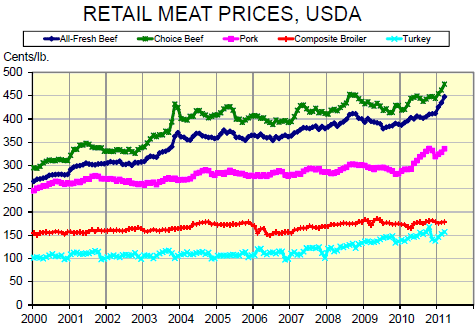



CME: Consumers Spend More on Meat and Poultry
US - CME Group exchanges will be closed April 22 in observance of Good Friday. Chicago trading floors, with the exception of Foreign Exchange and Interest Rate floors, will close at their regular times on Thursday. The two exception floors will close at 12:00 noon. Globex trading for lumber, dairy and livestock will close at 1:55 p.m. on Thursday while all other Globex markets will observe their regular closes. All exchanges will be closed Friday, 22 April. Globex dairy trading will reopen Sunday night while all others will open as normal on Monday morning, write Steve Meyer and Len Steiner.To expand on our discussion of food and meat CPIs and PPIs on Friday – While percentage changes are important, consumers spend dollars and we need to always consider the dollars that are now required to buy meat and poultry. The chart below contains USDA’s computed average retail prices for the various species. These prices are based on the same Bureau of Labor Statistics (BLS) data as the CPIs for each species which were in yesterday’s DLR.

Prices for Choice beef and All Fresh beef, which includes Select grade, store grade (many retail chains have specifications for beef that do not involve USDA grades) and no-grade beef were again record high in March at $4.747/pound and $4.475/pound, respectively. These price increases have been roughly commensurate in both magnitude and timing with the increase in wholesale beef prices, which were also record-high in March at $2.78/pound. That broke the October 2003 record set in the wake of the discovery of BSE in Canada and the resulting reduction in beef supplies here in the US.
What’s more, the increase in beef prices is not likely over. The 2010 calf crop was the smallest in 50 years and beef demand, both domestic and export, is strong. Feedlot inventories have been bloated since last fall with cattle that normally would have gone to wheat pasture, keeping fed cattle supplies larger than they normally would have been. But the piper must be paid at some point and it would be no surprise to see these strong cutout values and resulting retail prices continue later this year and into 2012.
USDA’s average retail pork price for March, at $3.357/pound, got very close to breaking last October’s record of $3.363 and, given the seasonal tendency for hog numbers to shrink and hog prices to rise as the weather warms, will almost certainly set new record this summer. How high might these prices go? Historical relationships of farm-level to retail prices suggest that $1.00-plus hogs would result in $3.60-plus retail pork.
Chicken prices remained roughly even with last month, gaining only 0.9 cents/pound to reach $1.785. That is still well short of their high of $1.857 back in May 2009 when, as expected, the broiler industry was the first to react to higher grain prices. Much of that “reaction”, though, was the bankruptcy and subsequent output reductions of Pilgrim’s Pride and the rest of the industry has maintained output levels since that time, keeping retail chicken prices in check. How long that can last in the current cost climate is a major point of debate at present. Anecdotal evidences tells us that chicken producers have been much more aggressive in pricing corn and soybean meal as this market has strengthened, insulating themselves from the highest of input prices. But production cuts at several smaller companies and some analysts’ predictions of bankruptcies given the current state of broiler margins indicate that higher broiler prices are again in the offing.
Meanwhile, turkey prices continue to trend upward as this sector manages production levels quite effectively. March’s $1.572/ pound average price is more than 10 cents/pound off of last fall’s record but even a semblance of turkey’s normal seasonal increase will carry these prices to new heights this summer and fall.
BOTTOM LINE: Consumers are having to fork over more dollars for meat and poultry as well as gasoline as well as many other food items. One reader asked us yesterday “Why on earth do they exclude food an energy to compute “core” inflation when food and energy are so important and contribute so much to price volatility?” That’s a good question that underlies the volatility in these markets and its impact on consumers. At present, consumers could back away from beef and pork in favor of chicken and turkey but even those prices are, in our opinion, bound to rise. And we must remember that the increases in beef and pork prices have NOT BEEN DRIVEN by large reductions in supply. Per capita domestic availability of pork and beef are down only 2.8 and 2.3 per cent, respectively, through February.








